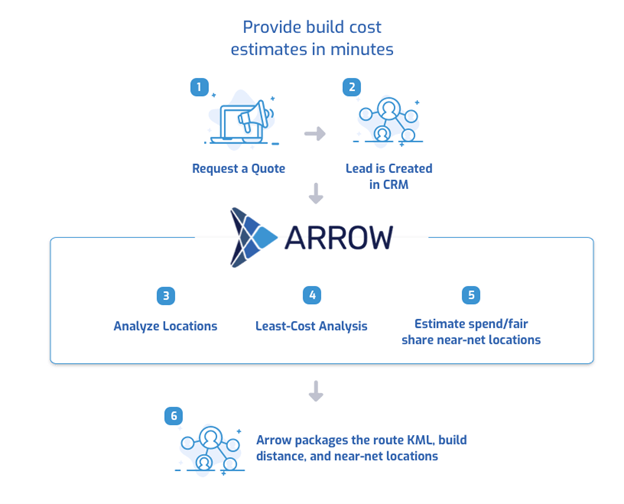PROYECTOS
Rapid RFP Response for North American Communications Infrastructure Provider
Challenge
Enterprises are continuing to increase their dependency on data, with more data loads and a geographically dispersed employee base demanding real-time performance. This increased demand has generated more deployments of dark and enterprise fiber, with providers eager to compete for a share of enterprise clients.
The client, a North American Communications Infrastructure provider, needed to quickly and comprehensively evaluate inbound requests for proposals (RFP) from prospects seeking high-bandwidth service for their enterprise locations, including both Fiber to the Enterprise (FTTE) and Fiber to the Tower (FTTT) deployments.
The client had a substantial regional network, requiring an accurate assessment of the distance from new locations to its existing network footprint as well as the cost to build and serve those locations with the right service level. A simple, near-net analysis provided an incomplete and potentially misleading answer, as fiber needs to be routed along road paths or other right-of-way conduits, not “as the crow flies.” In addition, other locations along the new fiber route should be considered for how their potential increased revenue opportunity could offset the costs quoted for the inbound RFP.
Further, the client had disparate systems, including network inventory, network planning, and CRM, being used by separate teams. This resulted in a multi-week delay and significantly larger workload for the engineering team tasked with supporting the sales team in evaluating and responding to inbound RFPs.
Solution
Our team worked closely with the client to map out the ideal workflow to automate the response for an inbound RFP request. The team leveraged Altman Solon’s Arrow platform and its extensible REST API to provide build cost estimates in real-time.
The client’s existing network footprint and splice points were uploaded into Arrow. Key cost assumptions (e.g., dollars per foot of fiber) and a set of area polygons defining which geographies are or are not serviceable by the client were configured in the Arrow platform.

The Arrow API was then integrated into the following workflow:
- A salesperson receives a request for a quote for one or more customer locations and enters the information into a sales mapping system.
- A lead is created in the CRM system from the mapping system input. When the salesperson is satisfied with the lead information, they submit for an estimate.
- The lead information is submitted to Arrow, which then matches each location to an existing set of addressable or non-addressable polygons to determine which locations to analyze.
- For all addressable locations, Arrow runs an independent least-cost analysis to connect to existing fiber or splice points (both options available) and generate the routes.
- Based on the least cost routes, Arrow calculates near-net locations along with their estimated spend and fair share to provide a more comprehensive view of the revenue potential.
- Arrow packages the route KML (Keyhole Markup Language), build distance, and near-net locations and sends them to the CRM system where the quote is processed.
This automated workflow was also set up for scale, allowing the client to submit multiple concurrent requests and process thousands of requests per month.
Results
Arrow was dynamically configured / integrated into the sales RFP process, providing build cost estimates in minutes vs. the prior manual estimation. Arrow’s comprehensive approach and seamless integration into existing systems allowed the client to submit competitive bids without compromising longer term financial and strategic considerations.
- With the implementation of Arrow, estimates are turned around in minutes rather than waiting in a queue for days before taking an engineer ~30 minutes to complete for each site.
- In addition to speed, Arrow also provides intelligence about opportunities along the route and the estimated spend, which can be factored into the business case and tracked.
- Arrow’s data outputs were easily integrated into an existing CRM system that’s familiar to the sales team, minimizing the time required for training and driving quick adoption of the new approach.
A competitive fiber to the enterprise or tower growth strategy requires speed in decision making. With the real-time and comprehensive intelligence of both cost and additional opportunity in serving a new site, communications infrastructure providers can confidently and effectively accelerate their growth.